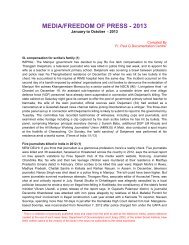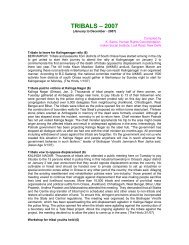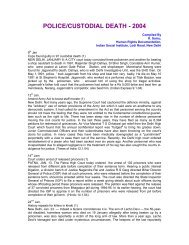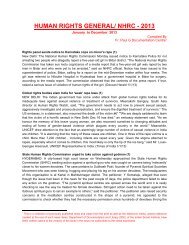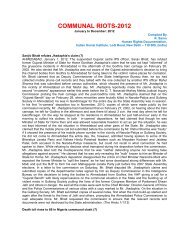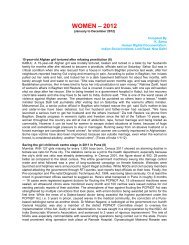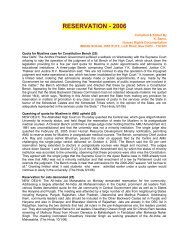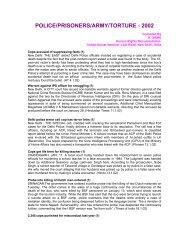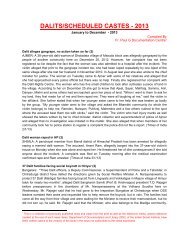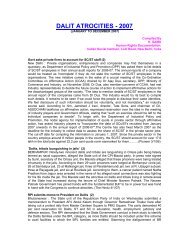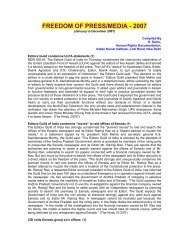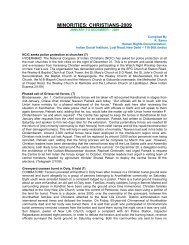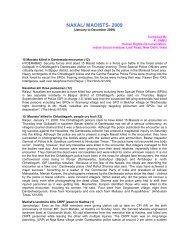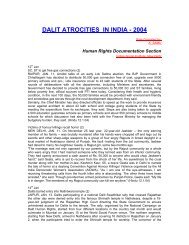Communal Violence and Inter-Community Relations - Indian Social ...
Communal Violence and Inter-Community Relations - Indian Social ...
Communal Violence and Inter-Community Relations - Indian Social ...
You also want an ePaper? Increase the reach of your titles
YUMPU automatically turns print PDFs into web optimized ePapers that Google loves.
COMMUNAL VIOLENCE AND INTER-COMMUNITY RELATIONS 33<br />
when, thanks to the distantiation, the objects at which the bureaucratic<br />
operation is aimed, can <strong>and</strong> are, reduced to a set of quantitative<br />
measures. Dehumanised objects cannot possibly possess a “cause”,<br />
much less a “just” one; they have no “interests” to be considered,<br />
indeed no claim to subjectivity. A strong identification with the same<br />
leads to social death, i.e., the natural death which follows subsequently<br />
is merely a corollary-anticipated <strong>and</strong> desired one!<br />
Ritualised riots <strong>and</strong> disparaged others<br />
The expressions of violence which concerned people at large in the<br />
wake of the Ramjanma bhoomi agitation was crafted around the<br />
perceptions of each others’ identity between the two communities. It<br />
believed that conflict can be caused by accentuating the feelings of<br />
threat for the majority community <strong>and</strong> by further highlighting the Muslims<br />
as disparaged others. Such threat perceptions were drawn from the<br />
mythical version of a tense past, an unresolved or knotty loss in the<br />
public memory. Rituals are associated with <strong>and</strong> are performed according<br />
to a given set of rites <strong>and</strong> happen to be a detailed method laying down<br />
procedures for following up. Rituals also channelise the aspirations into<br />
expressions of collectivity through a progression of performative acts.<br />
Rituals have much more agency <strong>and</strong> dynamism than what constitutes<br />
routine. When rituals are invented <strong>and</strong> propagated they are likely to<br />
generate ritualised minds in ritualised spaces. Participative minds in<br />
such altered <strong>and</strong> designated spaces find arenas where important <strong>and</strong><br />
critical reality is perched. On occasions, activities resemble customary<br />
practices, albeit conducted with more dramatic flair when othering is<br />
accomplished as critical social reality. Groups affirm their identities<br />
through practices that ritualise the routine of everyday life. Annihilations<br />
were always the ideal-typical examples of the violent episodes <strong>and</strong><br />
there was no dearth of them in the episodes of violence we witnessed<br />
since the unlocking of the gate at Faizabad. However, there are other<br />
facets of violence which have not received attention to the same degree<br />
i.e. executing deprivation for disparaged others, prohibiting purchase<br />
from their shops, refusing to supply them basic necessities such as<br />
milk, etc. Besides mental processes: feelings, attitudes <strong>and</strong> values that<br />
individuals <strong>and</strong> communities were made to hold, grounds were prepared<br />
for eruption, legitimisation <strong>and</strong> subsequent glorification of violence. Hate,<br />
fear <strong>and</strong> mistrust as driving feelings were deliberately pushed in the<br />
cognitive structures by the diverse agencies <strong>and</strong> instruments of Sangh



